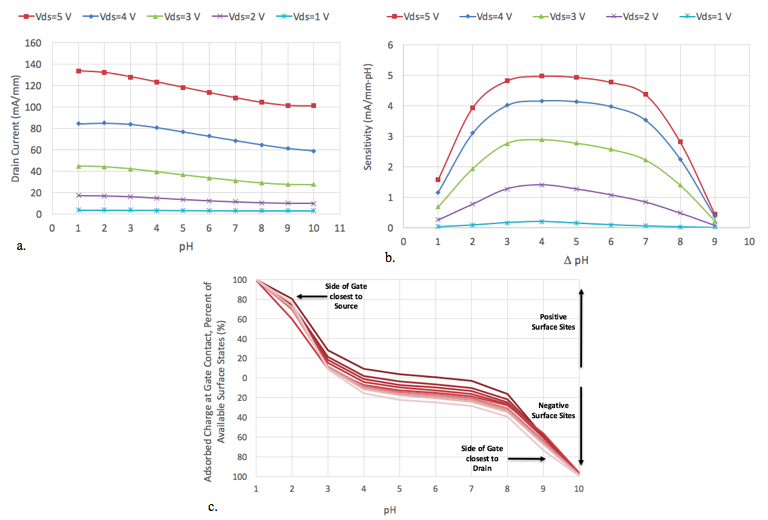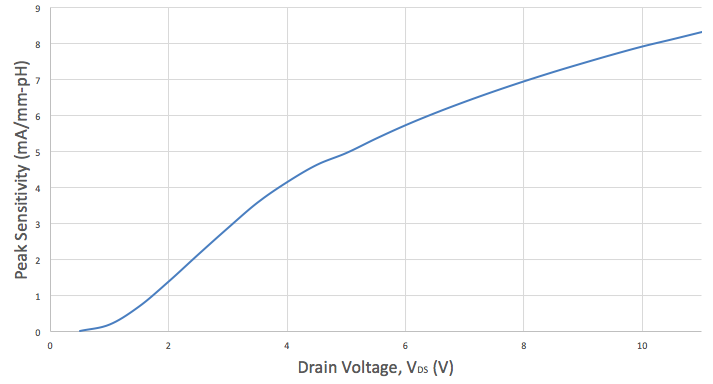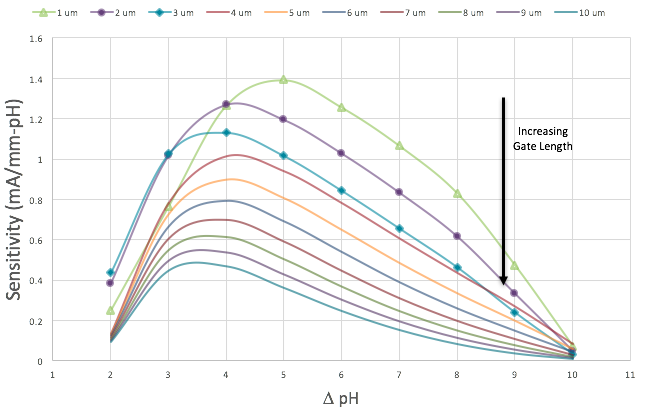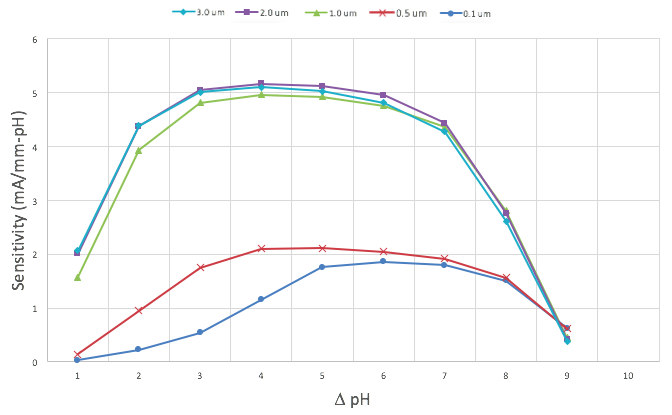AlGaN/GaN HEMT - chemical sensors
Optimization of GaN-based HEMTs for Chemical Sensing: A Simulation Study
This page provides a brief analysis of trends with parameters such as gate length and drain-to-source voltage with respect to sensitivity for AlGaN/GaN HEMT pH sensors.
Drain-to-Source Voltage and Sensitivity
First, sensor linearity and the effect of drain bias is investigated via a simulation study of one device with gate length equal to 1um. Figure 1a shows the drain current versus pH at drain biases ranging from 1V to 5V. Figure 1b extracts the sensitivity from Figure 1a confirming experimental results showing increased sensitivity with increased drain bias. The influence of drain bias on sensitivity is a useful trend for optimization, however, power requirements must be considered, particularly for in vivo devices. Figure 1c displays the corresponding absorbed charge at the gate for a drain bias of 5 V at specific positions across the gate surface. The family of curves shows the range of adsorbed charge across the gate from the leftmost side to the rightmost side. The much larger changes in interface charge going from pH values 1-3 and 8-10 correspond to smaller sensitivities. The linear region of this simulated device at high drain biases (4-5 V) is roughly from pH values 3 to 8, which corresponds to the linear region of change in interface charge.
Figure 1. a) Drain current versus pH with varied drain bias ranging from 1 V to 5 V with a 1 V increment for a 1um gate length device. b) Corresponding sensitivity versus delta pH. c) Corresponding percent of available surface charge at the gate contact vs. pH at a drain bias of 5 V. The top signifies positive surface site where the bottom is negative surface sites. Figure 1c is depicted across the gate, whereas Figure 1a and 1b are between the source and drain.
To determine the extent of increased sensitivity with drain bias, figure 2 depicts the peak sensitivity as a function of drain voltage for a 1 um gate length device. The peak sensitivity increases sharply from roughly 1V to 4 V and then shows an increasing trend with a smaller slope indicating a possible saturation point at higher drain voltages.
Figure 2. Simulated results of peak sensitivity (mA/mm-pH) as a function of drain voltage, VDS, for a 1um gate length AlGaN/GaN HEMT pH sensor.
Gate Length and Sensitivity
To determine the combined effect of drain bias and gate length on sensor linearity, simulation results for various gate lengths for a drain bias of 2 V (Figure 3) and 5 V (Figure 4) are given. As was shown in Figure 1, a drain bias of 2 V did not result in a Peak Sensitvity (mA/mm-pH) large linear sensitivity range. This results holds for lengths from 1 to 10 m (Figure 3). An interesting result is that the peak sensitivities decrease with increasing gate length. Figure 4 demonstrates simulation results of gate lengths ranging from 0.5 um to 3 um at a constant drain voltage of 5 V. Results for Figure 4 could not be expanded past a 3 um gate length due to convergence issues. These results indicate that at sufficiently high bias voltages, gate lengths with 1 um or higher have similar sensitivities and range of linearity. In Figure 4, any gate length below 1um provides lower sensitivity and a smaller range of linearity. This results suggests that one need no more than a gate length of 1 um to achieve a maximal sensitivity range.
Figure 3. Simulated sensitivity (mA/mm-pH) as a function of pH for varying gate lengths (1.0 m to 10.0 m) at a constant drain bias, Vds, of 2.0 V.
Figure 4. Simulated sensitivity (mA/mm-pH) as a function of pH for varying gate lengths (0.5 m to 3.0 m) at a constant drain bias, Vds, of 5.0 V.
Tutorial and Example Files
The files below can be used to obtain these results. The hemt_ph.tcl script is the main script which calls the other three header files. In hemt_ph.tcl, the gate length can be adjusted with the gateLinc variable. There are two places where this variable must be set and the initial gate length is 1um. Hence if the gate length variable is set to 0, the gate length of the device is 1um. This variable must be set to one minus the desired gate length, halved. For example, if the desired gate length is 2.5um, the variable should be set to 0.75; ((2.5-1)/2).
Note: for the section Net Adsorbed Charge v Position (Y-Direction), the y.v values must be changed to accommodate the new desired gate length with an estimated even spacing across the gate.
Copy and paste from pdfs into a text document with ".tcl" as the extension.
File:FLOODS - pH sensor.pdf - slides



